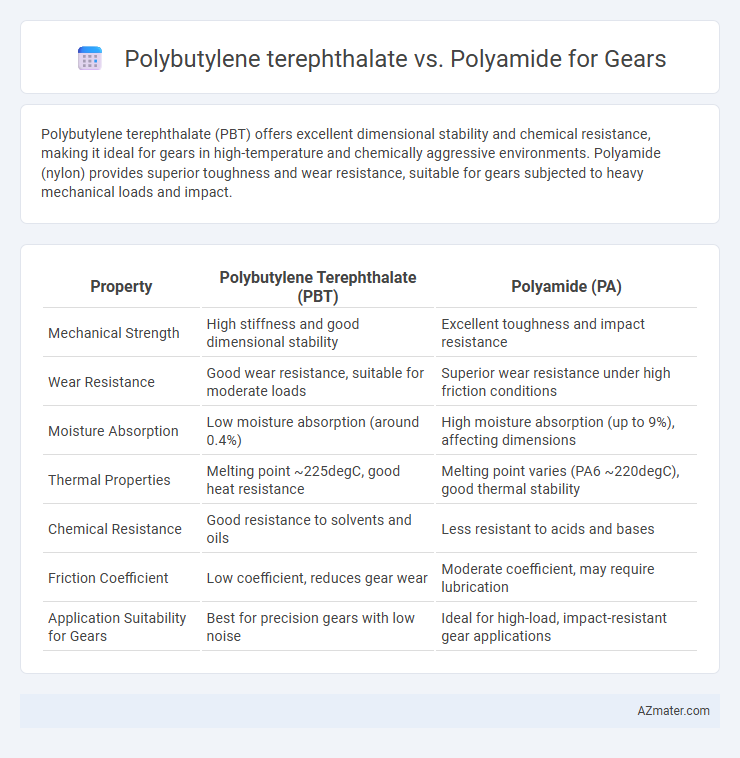Polybutylene terephthalate (PBT) offers excellent dimensional stability and chemical resistance, making it ideal for gears in high-temperature and chemically aggressive environments. Polyamide (nylon) provides superior toughness and wear resistance, suitable for gears subjected to heavy mechanical loads and impact.
Table of Comparison
| Property | Polybutylene Terephthalate (PBT) | Polyamide (PA) |
|---|---|---|
| Mechanical Strength | High stiffness and good dimensional stability | Excellent toughness and impact resistance |
| Wear Resistance | Good wear resistance, suitable for moderate loads | Superior wear resistance under high friction conditions |
| Moisture Absorption | Low moisture absorption (around 0.4%) | High moisture absorption (up to 9%), affecting dimensions |
| Thermal Properties | Melting point ~225degC, good heat resistance | Melting point varies (PA6 ~220degC), good thermal stability |
| Chemical Resistance | Good resistance to solvents and oils | Less resistant to acids and bases |
| Friction Coefficient | Low coefficient, reduces gear wear | Moderate coefficient, may require lubrication |
| Application Suitability for Gears | Best for precision gears with low noise | Ideal for high-load, impact-resistant gear applications |
Introduction to Polybutylene Terephthalate (PBT) and Polyamide (PA)
Polybutylene terephthalate (PBT) is a thermoplastic polymer known for its high strength, excellent dimensional stability, and resistance to chemicals and moisture, making it ideal for precision gears requiring low wear and noise. Polyamide (PA), commonly known as nylon, offers superior toughness, impact resistance, and excellent friction properties, which are essential for gears operating under high load and varying temperatures. Both materials provide distinct advantages depending on gear application demands, with PBT favoring stability and PA excelling in durability and flexibility.
Key Properties of PBT for Gear Applications
Polybutylene terephthalate (PBT) offers excellent dimensional stability, high tensile strength, and superior wear resistance, making it ideal for precision gear applications. Its low moisture absorption maintains mechanical properties under humid conditions, unlike polyamide which can swell and deform. Additionally, PBT's inherent electrical insulation and chemical resistance enhance gear durability in demanding industrial environments.
Key Properties of Polyamide for Gears
Polyamide, commonly known as nylon, offers exceptional wear resistance, high tensile strength, and excellent fatigue resistance, making it ideal for gear applications requiring durability and long service life. Its inherent self-lubricating properties reduce friction and noise, enhancing gear efficiency and operational smoothness. Furthermore, polyamide exhibits good chemical resistance and dimensional stability under varying temperatures, ensuring reliable gear performance in diverse industrial environments.
Mechanical Strength and Durability Comparison
Polybutylene terephthalate (PBT) offers excellent mechanical strength with high rigidity and good impact resistance, making it ideal for precision gears requiring dimensional stability under load. Polyamide (PA), commonly known as nylon, provides superior toughness and wear resistance, enhancing durability in dynamic gear applications exposed to friction and variable stress. While PBT excels in maintaining stiffness and resistance to creep, polyamide gears typically outperform in long-term fatigue resistance and self-lubricating properties, crucial for extended gear service life.
Wear and Friction Performance in Gears
Polybutylene terephthalate (PBT) offers excellent wear resistance and low friction characteristics, making it suitable for gears operating under moderate loads and speeds. Polyamide (PA), particularly Nylon 6 and Nylon 6,6, exhibits superior toughness and self-lubricating properties, which enhances its durability and reduces friction in high-load, high-speed gear applications. Comparative studies indicate polyamide gears generally outperform PBT in wear resistance and friction reduction, especially in harsh or demanding mechanical environments.
Moisture Absorption: PBT vs Polyamide
Polybutylene terephthalate (PBT) exhibits significantly lower moisture absorption compared to polyamide, typically absorbing less than 0.4% moisture by weight, whereas polyamide can absorb up to 9-10%. This difference results in PBT maintaining superior dimensional stability and mechanical properties in humid environments, crucial for gear applications requiring precise tolerances. Consequently, PBT gears tend to perform better under moisture exposure, reducing risks of swelling, deformation, and loss of strength common with polyamide components.
Chemical Resistance: PBT vs PA in Harsh Environments
Polybutylene terephthalate (PBT) exhibits superior chemical resistance compared to polyamide (PA) in harsh environments, particularly against hydrocarbons, oils, and solvents commonly encountered in gear applications. PBT's inherent resistance to hydrolysis and dimensional stability under chemical exposure make it ideal for sustained use in aggressive chemical conditions. Conversely, polyamide tends to absorb moisture and degrade faster when exposed to acidic or alkaline substances, limiting its longevity and performance in chemically demanding gear systems.
Processing and Machinability Differences
Polybutylene terephthalate (PBT) offers superior ease of processing due to its lower melting point and faster crystallization rate compared to polyamide (PA), enabling shorter cycle times in injection molding of gears. Polyamide gears benefit from better machinability thanks to their higher toughness and thermal resistance, allowing for precise finishing operations without compromising structural integrity. Processing PBT requires less moisture control to avoid hydrolysis, whereas polyamide demands stringent drying to prevent molding defects and achieve optimal mechanical properties in gear production.
Cost and Availability Considerations
Polybutylene terephthalate (PBT) offers a lower cost alternative to polyamide (PA) in gear manufacturing, benefiting from more affordable raw materials and simpler processing techniques. PBT's widespread availability in various grades ensures consistent supply and competitive pricing, making it ideal for high-volume production runs. In contrast, polyamide, while slightly more expensive due to its superior mechanical properties and resistance to wear, can experience supply variability influenced by petroleum-based raw material fluctuations.
Choosing the Right Material: PBT or Polyamide for Gears
Polybutylene terephthalate (PBT) offers excellent dimensional stability, chemical resistance, and lower moisture absorption, making it ideal for precision gears in automotive and electrical applications. Polyamide (PA), known for its superior toughness, impact resistance, and higher wear resistance under load, performs well in gears exposed to dynamic stress and varying temperatures. Selection depends on gear requirements: PBT suits environments demanding rigidity and chemical stability, while Polyamide excels in durability and mechanical strength under heavy-duty conditions.

Infographic: Polybutylene terephthalate vs Polyamide for Gear
 azmater.com
azmater.com